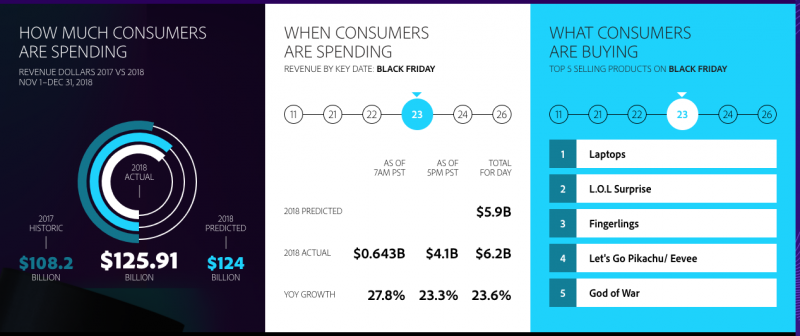The holiday season is an important time of year for your online brand, but one that comes with many challenges. These are three of the biggest inventory obstacles to overcome and the solutions to meet them head-on.
For online retailers, few days match the excitement and potential windfall of Black Friday and Cyber Monday. These two days alone stand as a testament to the big business that online shopping has become.
In 2018, online retailers pulled in $6.22 billion in sales on Black Friday.
A few days later, the increasing popularity of Cyber Monday helped to push the sales total even higher, with consumers spending a record-setting $7.9 billion on online purchases.
But the holiday shopping season is more than just two days long. The time between November and a few weeks into January can often make or break your entire year.
The outlook for 2019 confirms just how vital holiday sales will be. Deloitte is forecasting online sales for the full shopping season, from late November to early January, to approach $150 billion.
To reap the benefits of the most wonderful time of the shopping year, you need to ensure your ecommerce brand is ready to capitalize on the increased online traffic the holidays bring.
So how do you prepare?
Let's look at three common and critical stumbling blocks you'll face this season:
- Inventory Shortages
- Last-Minute Purchases
- Post-Purchase Customer Service
We'll also explore the solutions you can employ to meet these challenges head-on and find success on Black Friday, Cyber Monday, and beyond.
Challenge: Inventory Shortages
Stockouts are something you never hope to face, but it is a necessary evil of ecommerce. You work to prevent it all year, but during the holidays, the risk of a stockout can be high and particularly damaging to your business.
Not only will you lose sales, but you risk losing customers, many of which may not return if you're unable to meet the demand for a product they want.
The double-whammy of Black Friday and Cyber Monday often make stockouts more likely. This proves especially true if your online brand sees an uptick in business a few days or weeks before Black Friday.
And don't discount the day most people are supposedly eating turkey and watching football.
According to BlackFriday.com, last year's Thanksgiving Day online sales amounted to $3.7 billion. The Saturday (aka Small Business Saturday) and Sunday between Black Friday and Cyber Monday also saw $6.4 billion in sales.
Overall, from November 1 to November 26, there were $58.5 billion in online sales in 2018.

Source: Adobe
All of these numbers point to one thing - Black Friday and Cyber Monday are big days, but they're not the only days when consumers are shopping on your online store. If you don't correctly anticipate that "off-day" activity, you are more likely to run into a stockout scenario.
Another reason you might suffer inventory shortages is from the sheer volume of shoppers during the final two months of the year. Sales channels that may be slow producers during the prior ten months may see an increase in activity at holiday time.
With the crush of Cyber Monday, those underused sale channels turn into hotbeds of activity, unexpectedly cutting into inventory.
Solution: Begin Your Holiday Prep Early
You're sure to know the saying, "the early bird gets the worm." Well, in the case of ecommerce, the early bird can end up catching lots of worms.
There is no such thing as too early when it comes to preparing your ecommerce business for the holiday rush. Start your forecasting well before fall. Take into account that holiday shoppers start their planning and buying earlier and earlier.
Also, consider buyers who are post-holiday shoppers who either seek out deals after the fact or are ready to spend extra cash they received as gifts. You don't want to be the store that has fulfillment issues post-January 1st. Customers will remember if they can't purchase a product they want.
To this end, another critical factor with forecasting involves your supply chain. Secure your inventory in time to meet the first level of demand - typically by early November - and ensure your replenishment schedule keeps up with sales into the new year. Compare sales from the years prior and see if you can identify any trends, including:
- The average percentage of sales increase
- Sales volume across the full business
- The average percentage of sales increase in specific sales channels
Inventory management software streamlines this process and serves you well for both FBA and multichannel fulfillment. If you require help making sense of the planning that goes into your forecasting, consider consolidating the inventory tools and software you use.
A single solution (or at the very least narrowing down multiple tools to just a few) improves your analytical efficiency, allowing you to make sense of the data and act upon it much faster.
Finally, don't expect your inventory to fly off the digital shelf on its own. Organize and plan your marketing and sales strategy early to capitalize on the peaks and valleys of the season.
- Gear your advertising so that it builds excitement for your business in the run-up to Black Friday and Cyber Monday.
- Optimize product listings and promotional content with keywords - both short and long-tail - that you want to target.
- Engage with current customers to generate positive reviews and social proof well before Thanksgiving.
- Reintroduce your product offerings to past customers - in particular, those that made purchases during the previous holiday season - to bring them back into the fold using discount codes.
- Get creative with product offerings. Promote bundles and upsells that pair complementary products together to increase sales. Seek out opportunities to get your products in gift guides (or create your own) to broaden their reach.
- Don't shy from end-of-year promotions or deals for the New Year to maintain positive sales beyond the holiday season. You still need to move the remaining inventory, so create urgency with flash sales or limited sales windows.
The holiday shopping season may only be two to three months long, but don't hesitate to start inventory planning early.
Challenge: Last Minute Purchases
Well-organized consumers tying up holiday loose ends.
Savvy buyers holding out for the best available deal.
Customers who put off buying gifts until the last possible moment.
No doubt, last-minute purchases are as much a staple of the holidays as tinsel and lights. The evolution of online and down-to-the-wire shopping has resulted in the prevalence of next-day or expedited shipping requests.
The expectation of buying a product with no time to spare and receiving it a few days later can put a strain on your fulfillment capabilities. Further, an inability to meet the customer demand for fast (and free) shipping can prove harmful to your brand's overall reputation.
In the flurry of orders rolling in, it becomes difficult to think about optimizing your costs and selecting the best, cheapest rates to get orders to customers in time. Defaulting to the service your customers requested can cause your shipping costs to rise, which will eat into any profits you hope of making during the holidays.
Solution: Embrace Automation
Just as crucial to the products you offer, how those products are delivered is critical to your success. To achieve an uncomplicated and timely fulfillment strategy, leverage automation at each step possible to streamline your procedures.
From the moment an order is placed, automation can:
- Route orders to the warehouse that best serves as the origination point.
- Rate shop to assign the most favorable and cost-efficient shipping option to meet the delivery timeframe.
- Take on any redundant or repetitive tasks to maximize the productivity of your fulfillment team.
Your fulfillment processes are not exclusive to your customer orders. Inventory replenishment also benefits from automation.
Inventory management platforms pull data from your sales numbers and feed that information into forecasting algorithms. The result is a purchase order that includes an estimate of the replenishment numbers you need.
Instead of days or weeks to work out a replenishment schedule, you have it instantaneously.
Even with a finely tuned fulfillment structure, there are always points in the process you can improve on, including automation. Black Friday and Cyber Monday sales are only set to increase year over year, is only set to increase, so it's vital to capture as much data as possible from this year's holiday sales to help inform your future operations.
Ecommerce analytics data such as best selling products, top sales timeframes, average spend per visit, and items most often purchased in tandem help you lay out a blueprint for success during Black Friday, Cyber Monday, and the overall holiday season. Beyond that, it also enhances your supply chain and fulfillment strategy year-round.
Inventory management software also supports collecting and processing this data.
They create a throughline for your operations by seamlessly linking your sales, shipping, and warehousing (or FBA fulfillment) activities. You can better understand customer behavior and engagement, gain insight into how your structure is working, and identify opportunities for improvement.

Want to dig deeper into which key metrics to track during the holidays. Check out our webinar 9 Sales Metrics to Monitor During the Holidays.
We Cover:
- Operational KPIs that’ll actually move the sales needle
- How to stay ahead of consumer shopping demands in Q4
- Strategic ways to maintain profitability and growth
- Enticing customers to fill their shopping carts to the brim!
Challenge: Post-Purchase Customer Service
Purchasing from your online store doesn't spell the end of the story for your customers.
The customer experience - even after their initial engagement and purchasing from your brand - is directly linked to your business success. The numbers tell the tale:
- 93% of consumers will make a repeat purchase from firms with excellent customer service.
- 96% claim they would make a repeat purchase from a business that provided a top-notch return experience.
- 98% say that the delivery experience has a direct impact on their brand loyalty.
But how well does your ecommerce company meet those standards?
Consumers grow increasingly savvy with each New Year and are paying closer attention to what they purchase and how you handle those purchases. They notice small things, such as:
- Long wait times to get a questioned answered in a live chat or on the phone.
- Hard to understand or extremely narrow return or refund policies.
- Delayed or non-existent shipment tracking numbers or inconsistent follow-up.
The increase in customer activity during the feverish holiday season – especially the high-volume days from Black Friday to Cyber Monday – add plenty of stress to your customer service and fulfillment operations.
Solution: Clear (and Frequent) Communication
Similar to how you prep for your inventory, pull together a game plan for addressing increased customer activity well before the holiday season arrives.
Review your policies involving sales, ordering, delivery, returns, exchanges, and refunds. You want the language for each to be clear, concise, and easy for users to find on each of your sales channels and confirmation emails. You’ll also want to establish a policy for people who want to exchange a gift they received from someone else.
When it comes to customer promises, ensure your tech platforms can back it up. This includes:
- Making your online store fast and effortless to navigate with vital information clearly posted.
- Providing tracking information in a reasonable time after a purchase is made.
- Processing returns, exchanges, or refunds in a timely, stress-free manner.
- Your communications after the fact - whether its email, text, or through other channels - should over-communicate information to your customers at every point of engagement.
The more frequent and transparent information you provide, the fewer questions your customer service team will need to address.
Speaking of your customer service group, don't leave them understaffed or poorly equipped to address the increased workload that comes with the holidays.
- Anticipate when those inquiries will rise - the period from Black Friday to Cyber Monday, the days leading up to the final ship date to receive by December 25, and the weeks following that date when returns are highest.
- Use automation for common questions and answers and train your team to address inquiries regardless of the channel from which they originate, including social media.
- Put reps who are exceptionally well versed in social media platforms and communication on the front lines of your social channels and live chats.
A lousy customer service experience travels fast on Facebook, Twitter, or similar platforms. A savvy rep who speaks the language and understands the concerns can quickly make that experience a positive one.
Regular internal meetings in the months leading up to Black Friday - August, September, October - will also lay the groundwork for a unified service approach. You should include everyone in those meetings - your service, sales and marketing, and warehouse teams - and keep up regular touchpoints in November and December to maintain morale and a unified front.
Final Thoughts
A fully realized holiday inventory management approach while providing a quality customer experience will undoubtedly establish your brand as a favorite among consumers.
Proper planning, forecasting, and communications will help you capitalize on the significant online shopping days of Black Friday and Cyber Monday and propel your brand toward even greater success no matter the season.
Also, for more on this topic check out our ecommerce holiday checklist to nail holiday operations.








